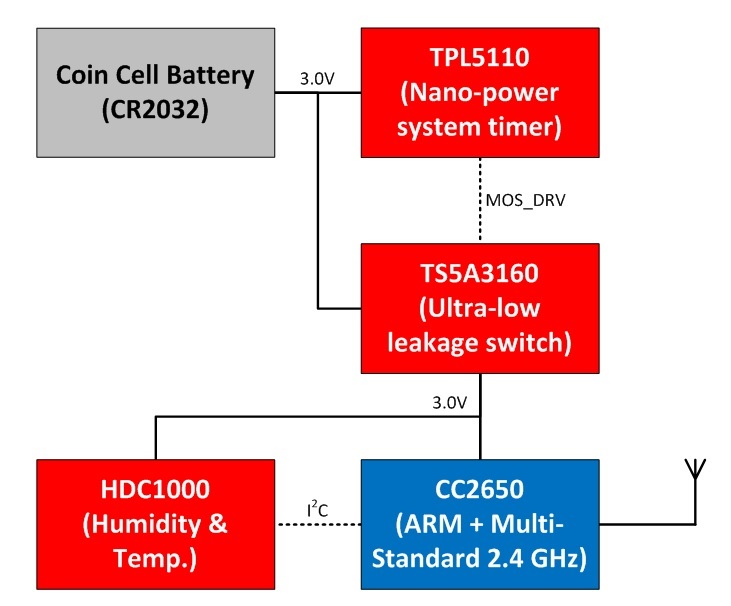SSZTCL1 june 2015 CC2630 , CC2640 , CC2650 , HDC1000 , HDC1008 , HDC1050 , TPL5100 , TPL5110 , TPS22860
With the expansion of the Internet of Things (IoT), the need for wireless sensor nodes is growing. Many different sensor types are being integrated into IoT networks: temperature, humidity, pressure and ambient light, just to name a few. As the desire to add sensing abilities to IoT networks increases, so does the importance of a sensor node’s battery life.
For example, if a commercial building is retrofitted with wireless sensor nodes to turn it into a smart building, it is conceivable that several thousand wireless sensor nodes may be installed to link various devices, such as thermostats, smoke and fire detectors and the like. Since it is impractical to run power cabling to every single node, batteries are a necessary power source. However, there is a significant labor cost when several thousand batteries need to be changed in all of those wireless sensor nodes.
To reduce cost and inconvenience associated with battery maintenance, it makes sense to ensure that every wireless sensor node has as long a battery life as possible. Most typical wireless sensor nodes employ a duty-cycled approach to extend battery life. This is a scheme whereby the node powers up, records a measurement from the sensor, transmits that data wirelessly to a central hub or gateway and then turns itself off, either by using a low-power mode or load switch. The main factors that affect overall system battery life are the on-state duration, on-state average current, off-state duration and off-state average current.
A TI Design reference design for humidity and temperature sensor nodes (TIDA-00374) demonstrates an optimized method to duty-cycle a wireless sensor node. A nano-power system timer and ultra-low leakage load switch are used in lieu of an internal wireless microcontroller (MCU) system timer to control when the wireless MCU and sensor receive power. A humidity sensor with an integrated temperature sensor is read by a wireless MCU to gather environmental data. Once the environmental data has been transmitted, the wireless MCU signals the nano-power system timer to remove power from the wireless MCU and humidity sensor. The system block diagram for this TI Design is shown in Figure 1.
 Figure 1 Humidity and Temperature
Sensor Node for Star Networks Enable 10+ Year Coin-cell Battery Life
Figure 1 Humidity and Temperature
Sensor Node for Star Networks Enable 10+ Year Coin-cell Battery LifeThis reference design optimizes overall system battery life, since the nano-power system timer and ultra-low leakage load switch reduce the off-state average current to tens of nanoamps, which is lower than most typical MCU shutdown modes. In addition, the wireless MCU and humidity sensor used in this reference design are extremely low power, which reduces the on-state average current to less than 5mA. Since the sensor measurement and wireless data transmission only take approximately 30ms to complete, the overall estimated system battery life is 10.5 years, when measuring once per minute.
This duty-cycled architecture using a nano-power system timer makes wireless sensor nodes a practical reality as IoT networks become more widespread. With system battery life longer than the typical shelf life of the batteries themselves, this TI Design reference design shows how practical wireless sensor nodes could be for a variety of new applications.
Additional Resources:
- Watch our training series to learn more about optimizing wireless sensor nodes.
- Check out the TI Design reference design for humidity and temperature sensor nodes (TIDA-00374), to download design guide, schematics, test data, design files, bill of materials and more.
- Read more in this blog on the proliferation of sensor nodes in the IoT.